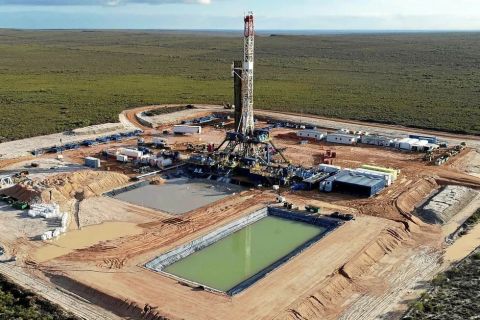
(Source: Shutterstock.com)
A matrix identifying when flaring is necessary with a shortened timeline for administrative action, best practices and new reports to provide greater accountability are among the suggestions from a coalition of oil and gas industry groups to help reduce flaring in Texas.
The report by the Texas Methane & Flaring Coalition was discussed June 16 during the Texas Railroad Commission (RRC) meeting. It comes as commissioners reach out to oil and gas industry players, environmental groups and other stakeholders as they seek ways to lessen the amount of natural gas flared from Texas oil fields.
Rising levels of flared gas has been driven mainly by higher oil production as operators drilled new wells prior to the latest downturn. While flaring is needed at times for safety reasons, some companies routinely flare gas more than others when economics or other factors are at play. Certain operators, however, have made it a priority to reduce flaring, putting gas to use, utilizing technology and making sure infrastructure is in place before bringing a well online.
The matrix, seen as a key component of the plan, gives companies several options based on their situations, guiding the application of Statewide Rule 32. The rule prohibits flaring of associated gas from initial completion beyond 10 producing days.
“The point is that operations are different and operators are different. But these steps will lead to reduced flaring,” Todd Staples, president of the Texas Oil and Gas Association (TxOGA), told commissioners. “Importantly, a part of that is to embrace emerging technology. We believe that innovation and technology is what has made Texas the energy capital of the world, and we think that will drive environmental progress in everything that we do.”
The coalition also recommended:
- Changes to the Statewide Rule 32 dataset to improve commission oversight and data collection;
- A proposed new report to follow up on the duration and actual volumes of flared gas, providing the commission with clear and usable data; and
- Adding another code in production report forms for flaring to enable operators to better account for flared and vented gas.
Among the best practices are setting reduction goals and continuous gas capturing planning, working with midstream, assessing facility designs to enhance gas-oil separation, improving gas quality for pipeline specifications and evaluating potentially beneficial technologies—all aimed to reduce flared volumes.
When flaring is necessary, recommended best practices are to minimize emissions via auto igniters, remote or onsite monitoring, automation, redundant ignition and maintenance programs, according to the report.
“We believe that we can get to the end of routine flaring,” Staples said. “We believe that more data is better data. It will enable the commission to do its job easier and more efficiently.”
He added that technology and innovation should be part of the process, pointing out companies that have seen positive results.
RRC Chairman Wayne Christian sees the need for a place for new technology ideas at the commission. He mentioned a program in North Dakota in which new technologies and techniques are pitched with the most promising ones getting state funding that is matched by industry.
“This is [an] opportune time to implement meaningful reforms to reduce flaring before oil and gas production climbs back to previous highs,” Christian said.
Kirk Edwards, president of Latigo Petroleum, suggested commissioners study limiting production in areas without plant capacity to take gas from newly drilled wells.
“This allowable mechanism would last until the plant has room,” for the gas wells, he said, noting this would apply to operators not drilling the first well on a new field.
For new wells drilled in an existing field with no immediate gas plant access, Edwards proposed commissioners allow the operator to flare natural gas production for no more than 90 days. No extensions would be given.
“The operator must then shut in the well until an adequate market is found for the well to produce into,” he said.
Wells permitted before July 1, and completed and producing before Oct. 1 would be grandfathered to flare as current statutes allow, he added.
Setting, Reaching Goals
Environmental groups also had ideas to share.
The Environmental Defense Fund (EDF) urged commissioners to develop a plan to eliminate routine flaring in Texas by 2025.
“We know this can be done because many of the leading operators are either already doing it or quickly working to achieve it,” said Colin Leyden, director of regulatory and legislative affairs for EDF.
RELATED: Permian Basin Flaring Puts Value of Natural Gas in Spotlight
Parsley Energy Inc. flared less than 3% of its total produced volumes in 2019. That dropped to less than 1% of its pro forma produced volumes in June following the acquisition of a company that had been flaring about 20% of its volumes, according to Stephanie Reed, senior vice president of corporate development, land and midstream for Parsley.
“This did not happen by accident, but rather required a methodical approach to reduce the flared volumes, including spending millions of dollars in necessary infrastructure,” she said.
Parsley’s roadmap includes an “aggressive corporate goal” tied to corporate compensation, reports detailing incidents to increase transparency and securing takeaway capacity before new wells start production.
Occidental Petroleum Corp. aims to have no routine flaring by 2030.
“The process to reduce flaring requires executive commitment and employee buy-in and ownership to reach our goal,” said Mike Starrett, vice president of HSE for Occidental’s domestic oil and gas operations.
Occidental’s approach involves site-specific planning including identifying and evaluating gas take away and facility design options; routine surveillance, maintenance and repair of well operations and emissions control equipment; training for engineers and operations personnel and accurate and timely reporting of flare events.
Next Steps
RRC staff will now look into the recommendations from the coalition as well as other panelists, which included presenters from Sierra Club and EarthX. Christian’s hope is to implement changes in the fall.
The coalition is comprised of members of a blue ribbon task force formed at Christian’s request. Besides TxOGA, member groups presenting included Texas Independent Producers & Royalty Owners, Texas Alliance of Energy Producers and the Permian Basin Petroleum Association.
Recommended Reading
ChampionX to Acquire RMSpumptools, Expanding International Reach
2024-03-25 - ChampionX said it expects the deal to extend its reach in international markets including the Middle East, Latin America and other global offshore developments.
Turnco Buys Drill Spec Services to Enhance OCTG Capabilities
2024-04-09 - Turnco said the integration of Drill Spec’s assets will expand its service offerings in West and South Texas.
Beacon Offshore Divests Non-op Gulf of Mexico Interests
2024-04-05 - Beacon Offshore Energy said that with its non-op assets divested, it would turn all of its focus to its Shenandoah and Winterfell assets in the Gulf of Mexico.
The JF Petroleum Group Acquires General Contractor GE Goodson Service
2024-04-15 - Following the transaction, GE Goodson will operate as The JF Petroleum Group’s Midland branch on a go-forward basis.
Triangle Energy, JV Set to Drill in North Perth Basin
2024-04-18 - The Booth-1 prospect is planned to be the first well in the joint venture’s —Triangle Energy, Strike Energy and New Zealand Oil and Gas — upcoming drilling campaign.





